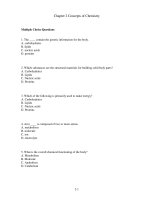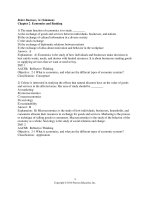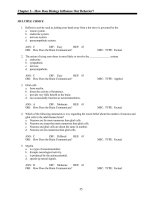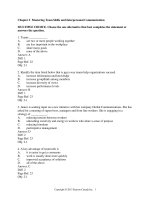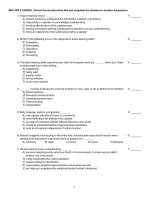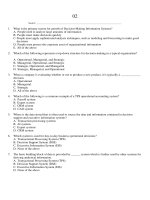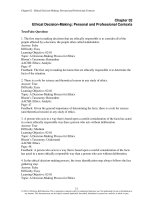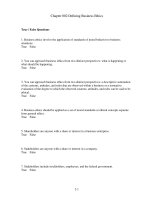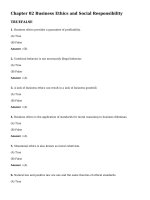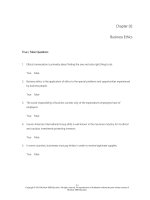International business the new realities 3rd edition cavusgil test bank
Bạn đang xem bản rút gọn của tài liệu. Xem và tải ngay bản đầy đủ của tài liệu tại đây (347.45 KB, 29 trang )
International Business: The New Realities, 3e (Cavusgil)
Chapter 2: Globalization of Markets and the Internationalization of the Firm
1) Nationalization refers to the gradual integration and growing interdependence of national
economies.
Answer: FALSE
Difficulty: Easy
Skill: Concept
Objective: 2-1
AACSB: Dynamics of the global economy
2) The initial phase of globalization was triggered by the introduction of the railroads and ocean
transport.
Answer: TRUE
Difficulty: Easy
Skill: Concept
Objective: 2-1
AACSB: Dynamics of the global economy
3) The Great Depression marked the beginning of the second phase of globalization.
Answer: FALSE
Difficulty: Easy
Skill: Concept
Objective: 2-1
AACSB: Dynamics of the global economy
4) The third phase of globalization was triggered by the development of personal computers, the
Internet, and Web browsers.
Answer: FALSE
Difficulty: Easy
Skill: Concept
Objective: 2-1
AACSB: Dynamics of the global economy
5) Firms expand abroad solely as a reaction to market globalization.
Answer: FALSE
Difficulty: Easy
Skill: Concept
Objective: 2-2
AACSB: Dynamics of the global economy
1
Copyright © 2014 Pearson Education, Inc.
6) Firms often internationalize proactively, in order to pursue new markets, find lower-cost
inputs, or obtain other advantages.
Answer: TRUE
Difficulty: Easy
Skill: Concept
Objective: 2-2
AACSB: Dynamics of the global economy
7) Firms that pursue internationalization as a strategic move tend to approach global competition
more aggressively than do firms that internationalize on a purely reactive basis.
Answer: TRUE
Difficulty: Easy
Skill: Concept
Objective: 2-2
AACSB: Dynamics of the global economy
8) Offshoring and the flight of jobs are prime drivers of market globalization.
Answer: FALSE
Difficulty: Easy
Skill: Concept
Objective: 2-2
AACSB: Dynamics of the global economy
9) Globalization of production activities and services is a dimension of market globalization.
Answer: TRUE
Difficulty: Easy
Skill: Concept
Objective: 2-2
AACSB: Dynamics of the global economy
10) Governments have facilitated economic integration by lowering barriers to international
trade and investment, harmonizing their monetary and fiscal policies within regional economic
integration blocs.
Answer: TRUE
Difficulty: Easy
Skill: Concept
Objective: 2-3
AACSB: Dynamics of the global economy
11) In a "common market," barriers to the cross-border flow of factors of production are
removed.
Answer: TRUE
Difficulty: Easy
Skill: Concept
Objective: 2-3
AACSB: Dynamics of the global economy
2
Copyright © 2014 Pearson Education, Inc.
12) The globalization of capital refers to the aggregate activities of firms that gives rise to
economic integration.
Answer: FALSE
Difficulty: Easy
Skill: Concept
Objective: 2-3
AACSB: Dynamics of the global economy
13) Converging tastes of consumers worldwide promote traditional lifestyles and values in
individual countries.
Answer: FALSE
Difficulty: Easy
Skill: Concept
Objective: 2-3
AACSB: Dynamics of the global economy
14) Companies strive to drive down prices through economies of scale, by standardizing what
they sell.
Answer: TRUE
Difficulty: Easy
Skill: Concept
Objective: 2-3
AACSB: Dynamics of the global economy
15) Falling trade barriers are facilitated by the WTO.
Answer: TRUE
Difficulty: Easy
Skill: Concept
Objective: 2-4
AACSB: Dynamics of the global economy
16) The end of the Cold War in 1989 hindered the forces of market liberalization in Eastern
Europe.
Answer: FALSE
Difficulty: Easy
Skill: Concept
Objective: 2-4
AACSB: Dynamics of the global economy
17) Industrialization implies that emerging markets are increasing their dependence on low-cost
labor.
Answer: FALSE
Difficulty: Easy
Skill: Concept
Objective: 2-4
AACSB: Dynamics of the global economy
3
Copyright © 2014 Pearson Education, Inc.
18) Technological advances have helped make internationalization affordable for all sizes of
firms.
Answer: TRUE
Difficulty: Easy
Skill: Concept
Objective: 2-5
AACSB: Dynamics of the global economy; Use of information technology
19) The Internet has increased the cost of transmitting voices, data, and images.
Answer: FALSE
Difficulty: Easy
Skill: Concept
Objective: 2-5
AACSB: Dynamics of the global economy; Use of information technology
20) Mobile phones are the most transformative technology in developing economies.
Answer: TRUE
Difficulty: Easy
Skill: Concept
Objective: 2-5
AACSB: Dynamics of the global economy; Use of information technology
21) Today, the cost of transportation, as a proportion of the value of products shipped
internationally, has increased dramatically.
Answer: FALSE
Difficulty: Easy
Skill: Concept
Objective: 2-5
AACSB: Dynamics of the global economy; Use of information technology
22) In international economics, codetermination refers to the tendency for a financial or
monetary crisis in one country to spread rapidly to other countries, due to integrated national
economies.
Answer: FALSE
Difficulty: Easy
Skill: Concept
Objective: 2-6
AACSB: Dynamics of the global economy
23) Large multinationals are not constrained by market forces because they can exert
considerable influence on governments through lobbying.
Answer: FALSE
Difficulty: Easy
Skill: Concept
Objective: 2-6
AACSB: Dynamics of the global economy
4
Copyright © 2014 Pearson Education, Inc.
24) To minimize globalization's harm and reap its benefits, governments should strive for
nationalized economic regimes.
Answer: FALSE
Difficulty: Easy
Skill: Concept
Objective: 2-6
AACSB: Dynamics of the global economy
25) The first wave of offshoring began in the 1990s with the exodus of service-sector jobs in
credit card processing, software code writing, accounting, health care, and banking services.
Answer: FALSE
Difficulty: Easy
Skill: Concept
Objective: 2-6
AACSB: Dynamics of the global economy
26) Countries that liberalize international trade and investment enjoy faster per-capita economic
growth.
Answer: TRUE
Difficulty: Easy
Skill: Concept
Objective: 2-6
AACSB: Dynamics of the global economy
27) Environmental destruction diminishes as economies develop, at least in the long run.
Answer: TRUE
Difficulty: Easy
Skill: Concept
Objective: 2-6
AACSB: Dynamics of the global economy
28) "McDonaldization" or "Coca-Colonization" of the world refers to the idea that globalization
can alter people's norms, values, and behaviors, which may tend to homogenize over time.
Answer: TRUE
Difficulty: Easy
Skill: Concept
Objective: 2-6
AACSB: Dynamics of the global economy
29) Globalization results in more demanding buyers who shop for the best deals worldwide.
Answer: TRUE
Difficulty: Easy
Skill: Concept
Objective: 2-7
AACSB: Dynamics of the global economy
5
Copyright © 2014 Pearson Education, Inc.
30) Market globalization compels firms to organize their sourcing, manufacturing, marketing,
and other value-adding activities on a strictly local scale.
Answer: FALSE
Difficulty: Easy
Skill: Concept
Objective: 2-7
AACSB: Dynamics of the global economy
31) Which of the following is characteristic of globalization of markets?
A) lack of skilled labor
B) conservatism
C) declining trade barriers
D) diminishing gap between the rich and the poor
Answer: C
Difficulty: Easy
Skill: Concept
Objective: 2-1
AACSB: Dynamics of the global economy
32) The first phase of globalization was characterized by the ________.
A) rise of steel production
B) rise of SMEs
C) dominance of MNEs in the agricultural industry
D) growth of railroads
Answer: D
Difficulty: Easy
Skill: Concept
Objective: 2-1
AACSB: Dynamics of the global economy
33) The ________ phase of globalization began around 1900 and was associated with the rise of
electricity and steel production.
A) first
B) second
C) third
D) fourth
Answer: B
Difficulty: Easy
Skill: Concept
Objective: 2-1
AACSB: Dynamics of the global economy
6
Copyright © 2014 Pearson Education, Inc.
34) The third phase of globalization was triggered by ________.
A) the end of World War II
B) the invention of electricity
C) the end of World War I
D) the Great Depression
Answer: A
Difficulty: Easy
Skill: Concept
Objective: 2-1
AACSB: Dynamics of the global economy
35) Which of the following reflects the major contribution of GATT to globalization?
A) It instituted strict controls on international currencies.
B) It simplified patent and copyright laws.
C) It reduced barriers to international trade and investment.
D) It eliminated the divide between the rich and the poor.
Answer: C
Difficulty: Easy
Skill: Concept
Objective: 2-1
AACSB: Dynamics of the global economy
36) The fourth phase of globalization is characterized by ________.
A) rise of railroads and ocean transport
B) reduction of barriers to trade by Western industrialized countries
C) the initiation of the Marshall Plan to reconstruct Europe
D) enormous growth of cross-border trade and investment
Answer: D
Difficulty: Easy
Skill: Concept
Objective: 2-1
AACSB: Dynamics of the global economy
7
Copyright © 2014 Pearson Education, Inc.
Internationalization Conference (Scenario)
At a conference on business internationalization strategies, representatives of three different
businesses meet to discuss a joint venture between their companies. Business A is located in a
country that internationalized during the second phase of globalization. Business B is based in a
country that internationalized during the third phase of globalization. Business C is located in an
emerging market country.
37) The representative from Business A is most likely from ________.
A) China
B) United Kingdom
C) Mexico
D) Brazil
Answer: B
Difficulty: Moderate
Skill: Application
Objective: 2-1
AACSB: Dynamics of the global economy
38) The representative from Business B is most likely from ________.
A) Panama
B) Hungary
C) Uganda
D) Japan
Answer: D
Difficulty: Moderate
Skill: Application
Objective: 2-1
AACSB: Dynamics of the global economy
39) The representative from Business C is most likely from ________.
A) Italy
B) Brazil
C) the United States
D) France
Answer: B
Difficulty: Moderate
Skill: Application
Objective: 2-1
AACSB: Dynamics of the global economy
8
Copyright © 2014 Pearson Education, Inc.
40) Over time, the GATT evolved into the ________.
A) World Bank
B) International Monetary Fund
C) World Trade Organization
D) World Intellectual Property Organization
Answer: C
Difficulty: Easy
Skill: Concept
Objective: 2-1
AACSB: Dynamics of the global economy
41) Early multinationals from the third phase of globalization originated in ________.
A) Japan
B) China
C) India
D) Brazil
Answer: A
Difficulty: Easy
Skill: Concept
Objective: 2-1
AACSB: Dynamics of the global economy
42) The fourth phase of globalization ________.
A) is characterized by the rise of electricity and steel production
B) is characterized by the rise of MNEs from Japan
C) witnessed the Bretton Woods Conference of twenty-three nations in 1947 that led to the
General Agreement on Tariffs and Trade
D) facilitated the globalization of the service sector in such areas as banking and retailing
Answer: D
Difficulty: Easy
Skill: Concept
Objective: 2-1
AACSB: Dynamics of the global economy
43) As market globalization intensifies, ________.
A) the gap between the rich and the poor shrinks rapidly
B) the distance between consumers worldwide expands
C) individual firms respond to the challenges and new advantages that it brings
D) firms internationalize solely as a reaction to it
Answer: C
Difficulty: Easy
Skill: Concept
Objective: 2-2
AACSB: Dynamics of the global economy
9
Copyright © 2014 Pearson Education, Inc.
44) Which of the following is a driver of globalization?
A) greater emphasis on proactive internationalization
B) internationalization of firm's value chain
C) integration of world financial markets
D) globalization of services
Answer: C
Difficulty: Easy
Skill: Concept
Objective: 2-2
AACSB: Dynamics of the global economy
45) Which of the following is a societal consequence of market globalization?
A) greater emphasis on proactive internationalization
B) internationalization of firm's value chain
C) new risks and instant rivalry from foreign competitors
D) offshoring and the flight of jobs
Answer: D
Difficulty: Easy
Skill: Concept
Objective: 2-2
AACSB: Dynamics of the global economy
46) Firms that are more successful at global competition display each of the following qualities
EXCEPT ________.
A) identifying foreign market opportunities aggressively
B) approaching internationalization from a reactive standpoint
C) actively pursuing partnerships with foreign firms
D) focusing intensively on building organizational capacities
Answer: B
Difficulty: Easy
Skill: Concept
Objective: 2-2
AACSB: Dynamics of the global economy
10
Copyright © 2014 Pearson Education, Inc.
Global Operations Report (Scenario)
As Vice President of Global Expansion for Pax Telecom, Deva Mikiri is tasked with preparing a
comprehensive report on the company's global operations over the past twenty years. Deva
assigns three strategists to collaborate on the History portion of the report, which details the
rationale behind Pax's decisions to expand operations in particular areas. Rashid Ahl focuses on
early expansion to China, which occurred after China began to make its market more accessible
to foreign companies. Markus Teller focuses on Pax's expansion to Eastern Europe, which was
motivated by increased industry privatization in key countries. Lavonne Jackson focuses on
expansion to Japan, which happened when the company's commercial bank expanded its service
network to Asia.
47) To which of the following drivers of market globalization is Markus most likely to attribute
his company's expansion to Eastern Europe?
A) advances in technology
B) integration of world financial markets
C) market liberalization
D) industrialization
Answer: C
Difficulty: Moderate
Skill: Application
Objective: 2-2
AACSB: Analytic skills
48) In terms of international business, market globalization can be viewed as a ________.
A) consequence of a strong emphasis on traditional values worldwide
B) consequence of the loss of national sovereignty
C) driver and consequence of firm-level internationalization
D) prime cause of rising diseconomies of scale in emerging economies
Answer: C
Difficulty: Moderate
Skill: Concept
Objective: 2-3
AACSB: Dynamics of the global economy
49) A value chain is ________.
A) the sequence of administrative policies implemented to promote economic integration by a
government
B) the process of relocating manufacturing and production to valuable and cost-effective
locations abroad
C) the process of integrating national economies during a financial crisis
D) the sequence of value-adding activities performed by a firm in the course of developing,
producing, marketing, and servicing a product
Answer: D
Difficulty: Easy
Skill: Concept
Objective: 2-3
AACSB: Dynamics of the global economy
11
Copyright © 2014 Pearson Education, Inc.
50) Regional economic integration blocs ________.
A) reduce trade and investment barriers
B) reduce private investments
C) adopt a hostile stance toward the private sector
D) hinder the cross-border flow of factors of production
Answer: A
Difficulty: Easy
Skill: Concept
Objective: 2-3
AACSB: Dynamics of the global economy
51) Which of the following is an example of a supranational institution?
A) the World Intellectual Property Organization
B) the UNICEF
C) the Red Cross
D) the World Trade Organization
Answer: D
Difficulty: Easy
Skill: Concept
Objective: 2-3
AACSB: Dynamics of the global economy
52) Governments have facilitated economic integration by ________.
A) increasing barriers to international trade and investment
B) developing supranational institutions to further reduce trade barriers
C) adopting different monetary and fiscal policies within the same regional economic integration
blocs
D) standardizing consumer lifestyles and preferences
Answer: B
Difficulty: Easy
Skill: Concept
Objective: 2-3
AACSB: Dynamics of the global economy
53) The free movement of capital around the world is also known as ________.
A) bond-based debt financing
B) contagion
C) the globalization of capital
D) common market arrangement
Answer: C
Difficulty: Easy
Skill: Concept
Objective: 2-3
AACSB: Dynamics of the global economy
12
Copyright © 2014 Pearson Education, Inc.
54) ________ refers to the sequence of value-adding activities performed by the firm in the
course of developing, producing, marketing, and servicing a product.
A) A value chain
B) A supply chain
C) Value gap
D) Value migration
Answer: A
Difficulty: Easy
Skill: Concept
Objective: 2-3
AACSB: Dynamics of the global economy
55) Companies strive to drive down prices ________.
A) by centralizing manufacturing and procurement to a single source
B) by standardizing what they sell
C) by thwarting the growth of supranational institutions
D) by discouraging competition
Answer: B
Difficulty: Easy
Skill: Concept
Objective: 2-3
AACSB: Dynamics of the global economy
56) Convergence of consumer preferences has led to an enhanced emphasis on standardization
which implies that ________.
A) the consistently rising prices of consumer goods have led to a demand vacuum in the market
B) the distance between consumers worldwide has increased with the advent of technology
C) the raw materials, parts, and components sourced by professional buyers are very similar in
design and structure
D) the globalization of services has adversely affected the quality of service worldwide
Answer: C
Difficulty: Moderate
Skill: Concept
Objective: 2-3
AACSB: Dynamics of the global economy
57) Reduction in trade barriers is associated with the emergence of ________.
A) fragmentary monetary and fiscal policies across the borders
B) regional economic integration blocs
C) widespread violation of intellectual property rights law
D) violation of GATT provisions
Answer: B
Difficulty: Easy
Skill: Concept
Objective: 2-3
AACSB: Dynamics of the global economy
13
Copyright © 2014 Pearson Education, Inc.
Global Operations Report (Scenario)
As Vice President of Global Expansion for Pax Telecom, Deva Mikiri is tasked with preparing a
comprehensive report on the company's global operations over the past twenty years. Deva
assigns three strategists to collaborate on the History portion of the report, which details the
rationale behind Pax's decisions to expand operations in particular areas. Rashid Ahl focuses on
early expansion to China, which occurred after China began to make its market more accessible
to foreign companies. Markus Teller focuses on Pax's expansion to Eastern Europe, which was
motivated by increased industry privatization in key countries. Lavonne Jackson focuses on
expansion to Japan, which happened when the company's commercial bank expanded its service
network to Asia.
58) In describing the main driver behind Pax's expansion to China, Rashid is most likely to
emphasize ________.
A) high rate of employee attrition in China
B) advances in technology
C) reduction of barriers to trade
D) integration of world financial markets
Answer: C
Difficulty: Moderate
Skill: Concept
Objective: 2-4
AACSB: Analytic skills
59) Which of the following drivers of market globalization is Lavonne's research most likely to
recognize as the factor responsible for the company's expansion to Japan?
A) integration of world financial markets
B) the highly conservative nature of the Japanese economy
C) the rise of monopoly markets in Japan
D) reduction of barriers to investment
Answer: A
Difficulty: Moderate
Skill: Concept
Objective: 2-4
AACSB: Analytic skills
60) ________ marked the end of the 50-year Cold War and smoothed the integration of former
command economies into the global economy.
A) The end of the World War II
B) The Bolshevik Revolution in Russia
C) China's free-market reforms
D) China's move to join the WTO
Answer: C
Difficulty: Easy
Skill: Concept
Objective: 2-4
AACSB: Dynamics of the global economy
14
Copyright © 2014 Pearson Education, Inc.
61) Financial market integration makes it possible for internationally active firms to ________.
A) nationalize manufacturing industries
B) minimize offshoring
C) increase tariffs on the import of automobiles and industrial machinery
D) engage in foreign currency transactions
Answer: D
Difficulty: Easy
Skill: Concept
Objective: 2-4
AACSB: Dynamics of the global economy
62) The globalization of finance ________.
A) enables companies to minimize offshoring
B) contributes to firms' abilities to develop and operate world-scale production and marketing
C) discourages innovation
D) discourages free international exchange of goods and services
Answer: B
Difficulty: Easy
Skill: Concept
Objective: 2-4
AACSB: Dynamics of the global economy
63) Which of the following statements is true of technological advances?
A) It provides a means for globalization to happen.
B) It discourages internationalization.
C) It inhibits the growth of new products and services.
D) It helps consolidate traditional values among consumers worldwide.
Answer: A
Difficulty: Easy
Skill: Concept
Objective: 2-5
AACSB: Dynamics of the global economy; Use of information technology
64) Technological leapfrogging is defined as ________.
A) adopting new technology late in the hype cycle
B) adopting new technology as soon as it is released
C) bypassing certain stages of technology to come up with a radical innovation when upgrading
to new products
D) boosting demand artificially by postponing the sale of new technology in the market
Answer: C
Difficulty: Easy
Skill: Concept
Objective: 2-5
AACSB: Dynamics of the global economy; Use of information technology
15
Copyright © 2014 Pearson Education, Inc.
65) The science and process of creating and using information resources is known as ________.
A) information design
B) information technology
C) psychographics
D) demographics
Answer: B
Difficulty: Easy
Skill: Concept
Objective: 2-5
AACSB: Dynamics of the global economy; Use of information technology
66) Which of the following benefits of IT is specific to smaller firms?
A) It mitigates organizational anarchy.
B) It creates competitive advantages by encouraging organizational learning.
C) It aids in the consolidation of market monopolies.
D) It allows firms to design and produce customized products they can target to narrow, crossnational market niches.
Answer: D
Difficulty: Moderate
Skill: Concept
Objective: 2-5
AACSB: Dynamics of the global economy; Reflective thinking skills
67) ________ are the most transformative technology in developing economies.
A) Mobile phones
B) Televisions
C) Intranets
D) E-mails
Answer: A
Difficulty: Easy
Skill: Concept
Objective: 2-5
AACSB: Dynamics of the global economy; Use of information technology
68) Technological advances have contributed to manufacturing by ________.
A) promoting traditional lifestyles and values
B) reducing cross-border flow of factors of production
C) promoting nationalization
D) reducing production costs
Answer: D
Difficulty: Easy
Skill: Concept
Objective: 2-5
AACSB: Dynamics of the global economy; Use of information technology
16
Copyright © 2014 Pearson Education, Inc.
69) Stella manages the production team at Camden Inc., a manufacturer of heavy industry
machinery in the United States. She needs to decide if her firm should export finished products
or manufacture abroad. Which of the following would most likely help her evaluate the best
alternative in this instance?
A) What is the gross national income of the United States?
B) What are the costs of transporting raw materials, components, and finished products?
C) Is employee empowerment culturally favored in the United States?
D) What is the average annual rate of employee turnover in the manufacturing industry?
Answer: B
Difficulty: Moderate
Skill: Application
Objective: 2-5
AACSB: Analytic skills
70) ________ refers to the tendency of a financial or monetary crisis in one country to spread
rapidly to other countries, due to the ongoing integration of national economies.
A) Contagion
B) Nationalization
C) Internationalization
D) Codetermination
Answer: A
Difficulty: Easy
Skill: Concept
Objective: 2-6
AACSB: Dynamics of the global economy
71) The ability of a nation to govern its own affairs is known as ________.
A) sovereignty
B) liberalization
C) interdependence
D) homogenization
Answer: A
Difficulty: Easy
Skill: Concept
Objective: 2-6
AACSB: Dynamics of the global economy
17
Copyright © 2014 Pearson Education, Inc.
72) The relocation of manufacturing and other value-chain activities to cost-effective locations
abroad is known as ________.
A) insourcing
B) cultural imperialism
C) contagion
D) offshoring
Answer: D
Difficulty: Easy
Skill: Concept
Objective: 2-6
AACSB: Dynamics of the global economy
73) Which of the following is an example of offshoring?
A) Fahad, a resident of the UAE can share his views—data and information—about the country's
construction industry with his friends in the U.S.
B) The IT support services for customers of Mayfair Inc., a U.S. based consumer electronics
manufacturer, are based in India.
C) Treat Corp. is a food and beverage manufacturer based in Texas. It decided to move from
Houston to Fort Worth in Texas to cut production costs.
D) Lin, a Chinese citizen, decides to move to the U.K. after her application for scholarship is
accepted by a leading university in London.
Answer: B
Difficulty: Moderate
Skill: Application
Objective: 2-6
AACSB: Dynamics of the global economy
74) An underground economy ________.
A) refers to the informal economic sector
B) refers to the formal economic sector
C) is characterized by dominantly legal transactions
D) is regulated and monitored by public authorities
Answer: A
Difficulty: Easy
Skill: Concept
Objective: 2-6
AACSB: Dynamics of the global economy
18
Copyright © 2014 Pearson Education, Inc.
75) While a degree of cultural imperialism may be at work, it is offset by the countertrend of
________.
A) offshoring
B) McDonaldization
C) privatization
D) local nationalism
Answer: D
Difficulty: Easy
Skill: Concept
Objective: 2-6
AACSB: Dynamics of the global economy
Globalization Debate (Scenario)
In his international business class, Professor Jang organizes a debate on the societal effects of
market globalization. Juan Prince takes a position that highlights the negative effects of market
globalization. He emphasizes how multinational enterprises can wield so much influence that
they threaten national sovereignty. He also notes the prevalence of low wages and sweatshop
conditions as firms utilize low-cost labor abroad. Juan then describes the detrimental effects of
corporate pollution on the environment, and he ends his argument by explaining how market
globalization helps homogenize national cultures. Rina Taylor is assigned to counter Juan's
position.
76) Which of the following is Rina most likely to cite as a counter example to Juan's argument
regarding the influence of MNEs on national sovereignty?
A) the dominating influence of market forces on the global economy
B) technological advances in computer-aided design of products
C) the political influence of large firms such as Walmart
D) the actual GDPs of underdeveloped economies
Answer: A
Difficulty: Moderate
Skill: Critical Thinking
Objective: 2-6
AACSB: Dynamics of the global economy; Reflective thinking skills
77) Which of the following most likely supports Rina's argument over Juan's concerning wages
and working conditions in developing countries?
A) Most African countries today still suffer from low or negative GDP growth.
B) Vietnam has experienced a five-fold increase in wages as a result of the growth of the
footwear industry there.
C) The move of Electrolux to Mexico cost Michigan 2,700 jobs.
D) Minimum wages should be established at set levels, regardless of the impact on the number of
jobs.
Answer: B
Difficulty: Moderate
Skill: Critical Thinking
Objective: 2-6
AACSB: Dynamics of the global economy; Reflective thinking skills
19
Copyright © 2014 Pearson Education, Inc.
78) Rina is most likely to counter Juan's claim regarding environmental effects by pointing out
which of the following?
A) The intensity of environmental pollution is far greater in emerging economies than in
undeveloped ones.
B) China's landscape was permanently altered by the construction of the Three Gorges Dam.
C) Environmental destruction tends to diminish in the long run, as economies develop.
D) Attempts at foreign cultural imperialism are often blocked by national governments.
Answer: C
Difficulty: Moderate
Skill: Critical Thinking
Objective: 2-6
AACSB: Dynamics of the global economy; Reflective thinking skills
79) Which of the following statements most likely to counters Juan's argument concerning the
homogenization of national cultures?
A) As globalization standardizes superficial aspects of life across national cultures, people resist
these forces by insisting on their national identity and taking steps to protect it.
B) Foreign values tend to shift not just superficial aspects of culture, but deeply held beliefs as
well.
C) Material goods such as cell phones and computers are found in most homes throughout the
world.
D) In most industries, domestic operation alone cannot sustain competitive business growth.
Answer: A
Difficulty: Moderate
Skill: Critical Thinking
Objective: 2-6
AACSB: Dynamics of the global economy; Reflective thinking skills
80) The most direct implication of market globalization is on the firm's ________.
A) value chain
B) supply chain
C) internal stakeholders
D) top management
Answer: A
Difficulty: Easy
Skill: Concept
Objective: 2-7
AACSB: Dynamics of the global economy
20
Copyright © 2014 Pearson Education, Inc.
81) Which of the following statements is true about value chain and international business?
A) Exporting firms perform most of the downstream value chain activities in the home market.
B) Exporting firms perform most of the upstream value chain activities in the home market.
C) Exporting firms perform most of the upstream value chain activities abroad.
D) Exporting firms perform most of the research and product development and production
abroad.
Answer: B
Difficulty: Moderate
Skill: Concept
Objective: 2-7
AACSB: Dynamics of the global economy
82) In a typical value chain, the firm ________.
A) rarely conducts research and development
B) performs most upstream value-chain activities abroad, when exporting
C) performs marketing activities such as pricing, promotion, and selling
D) performs most downstream activities in the home market, when exporting
Answer: C
Difficulty: Moderate
Skill: Concept
Objective: 2-7
AACSB: Dynamics of the global economy
83) Which of the following statements is true about the firm-level consequences of market
globalization?
A) The globalization of markets has narrowed down new business opportunities for
internationalizing firms.
B) Globalization drives firms to relocate key value-adding activities to the most advantageous
locations around the world.
C) A firm's value chain is not subject to internationalization.
D) Through offshoring, a firm relocates a major value-chain activity by establishing a factory or
subsidiary in the home market.
Answer: B
Difficulty: Moderate
Skill: Concept
Objective: 2-7
AACSB: Dynamics of the global economy
21
Copyright © 2014 Pearson Education, Inc.
84) Which of the following stages comes before procurement in a firm's value chain?
A) research & development
B) marketing
C) manufacturing
D) distribution
Answer: A
Difficulty: Easy
Skill: Concept
Objective: 2-7
AACSB: Dynamics of the global economy
85) Which of the following represents the final stage in a firm's value chain?
A) marketing
B) procurement
C) research & development
D) sales and service
Answer: D
Difficulty: Easy
Skill: Concept
Objective: 2-7
AACSB: Dynamics of the global economy
22
Copyright © 2014 Pearson Education, Inc.
Acme Software (Scenario)
Acme Software is a U.S.-based maker of software products for the health care industry. Recently
Acme has been investigating whether it would be beneficial to internationalize some of its valuechain activities. Acme hires a consulting group to help determine which, if any, value-chain
activities could be conducted abroad to promote business growth. The consulting group identifies
two health care software development companies in India that could provide programming
services at a lower cost than Acme's current expenditures for programming. In addition, the
consultants conduct international market research which shows that German health care
companies have a strong demand for the type of software that Acme offers.
86) Which of the following activities in Acme's value chain would be internationalized if Acme
decides to establish a development contract with one of the Indian software firms?
A) sales
B) distribution
C) marketing
D) procurement
Answer: D
Difficulty: Easy
Skill: Application
Objective: 2-7
AACSB: Dynamics of the global economy
87) Which of the following would be most important for the consulting group to consider when
deciding whether to recommend that Acme internationalize its sales efforts to Germany?
A) Will Acme save money on advertising by targeting small rather than large companies?
B) How intense is the competition from German companies offering similar products?
C) What type of training is received by programmers in software firms abroad?
D) Is employee empowerment culturally favored in Germany?
Answer: B
Difficulty: Easy
Skill: Critical Thinking
Objective: 2-7
AACSB: Dynamics of the global economy; Reflective thinking skills
88) Which of the following would be most important for Acme to determine before outsourcing
its programming services to India?
A) What benefits have Indian companies gained historically from internationalizing their valuechain activities?
B) Do Indian businesses outsource value-chain activities to Europe?
C) Would the lower cost of outsourcing allow Acme to sustain a competitive advantage in its
business operations?
D) Is either of the Indian health care companies interested in moving their operations abroad?
Answer: C
Difficulty: Easy
Skill: Critical Thinking
Objective: 2-7
AACSB: Dynamics of the global economy; Reflective thinking skills
23
Copyright © 2014 Pearson Education, Inc.
89) Describe the role of GATT and the WTO in reducing barriers to trade and investment
worldwide, and explain how this reduction has led to the integration and interdependence of
national economies.
Answer: The Bretton Woods Conference of twenty-three nations in 1947 led to the General
Agreement on Tariffs and Trade (GATT) and a series of negotiations that, over time, reduced
barriers to international trade and investment. Participating governments recognized that
liberalized trade would stimulate industrialization, modernization, and better living standards.
The GATT eventually transformed into the World Trade Organization, a multilateral governing
body that grew to include 149 member nations. The WTO aims to regulate and ensure fairness
and efficiency in global trade and investment. Global cooperation in the post-war era gave birth
to other international organizations such as the International Monetary Fund and the World
Bank.
Internationally active firms devise multicountry operations through trade, investment, geographic
dispersal of company resources, and integration and coordination of value-chain activities.
Governments have facilitated this integration by lowering barriers to international trade and
investment, harmonizing their monetary and fiscal policies within regional economic integration
blocs (also known as trade blocs), and developing supranational institutions—the World Bank,
International Monetary Fund, World Trade Organization, and others—that seek further
reductions in trade and investment barriers.
Difficulty: Moderate
Skill: Synthesis
Objective: 2-1, 2-3
AACSB: Dynamics of the global economy
90) In a short essay, discuss the impact of market globalization on consumer lifestyles and
preferences around the world. Provide examples to illustrate your answer.
Answer: Around the world, consumers spend their money and time in increasingly similar ways.
Lifestyles and preferences are converging. Shoppers in Tokyo, New York, and Paris demand
similar household goods, clothing, automobiles, and electronics. Teenagers everywhere are
attracted to iPods, Levi's jeans, and BlackBerry cell phones. Major brands have gained a global
following, encouraged by greater international travel, movies, global media, and the Internet,
which expose people to products, services, and living patterns from around the world. Movies
such as Transformers and The Twilight Saga receive much attention from a global audience.
Convergence of preferences is also occurring in industrial markets, where professional buyers
source raw materials, parts, and components that are increasingly standardized—that is, very
similar in design and structure. Yet, even as converging tastes facilitate the marketing of highly
standardized products and services to buyers worldwide, they also promote the loss of traditional
lifestyles and values in individual countries.
Difficulty: Moderate
Skill: Concept
Objective: 2-3
AACSB: Dynamics of the global economy
24
Copyright © 2014 Pearson Education, Inc.
91) How has the adoption of free markets worldwide served as a driver of market globalization?
Provide three examples to support your answer.
Answer: The collapse of the Soviet Union's economy in 1989 and China's free-market reforms
marked the end of the 50-year Cold War and smoothed the integration of former command
economies into the global economy. Numerous East Asian economies, stretching from South
Korea to Malaysia and Indonesia, had already embarked on ambitious market-based reforms.
India joined the trend in 1991. These events opened roughly one-third of the world to freer
international trade and investment. China, India, and Eastern Europe have become some of the
most cost-effective locations for producing goods and services worldwide. Privatization of
previously state-owned industries in these countries has encouraged economic efficiency and
attracted massive foreign capital into their national economies.
Difficulty: Moderate
Skill: Concept
Objective: 2-4
AACSB: Dynamics of the global economy
92) What is implied by industrialization? How does it bring about economic development? What
is modernization?
Answer: Industrialization implies that emerging markets—rapidly developing economies in
Asia, Latin America, and Eastern Europe—are moving from being low value-adding commodity
producers, dependent on low-cost labor, to sophisticated competitive producers and exporters of
premium products such as electronics, computers, and aircraft. For example, Brazil is now a
leading producer of private aircraft, and the Czech Republic excels in the manufacture of
automobiles. As highlighted in the opening story, India has become a leading supplier of
computer software. Economic development is enhancing standards of living and discretionary
income in emerging markets. Perhaps the most important measure of economic development is
gross national income (GNI) per head. Modernization is increasing the attractiveness of
emerging markets as investment targets and facilitating the spread of ideas, products, and
services across the globe.
Difficulty: Moderate
Skill: Concept
Objective: 2-4
AACSB: Dynamics of the global economy; Use of information technology
25
Copyright © 2014 Pearson Education, Inc.
